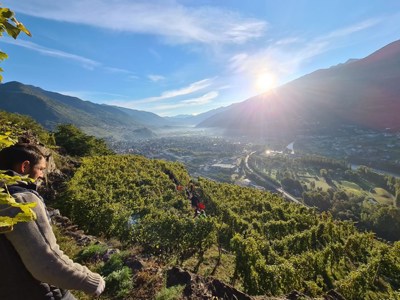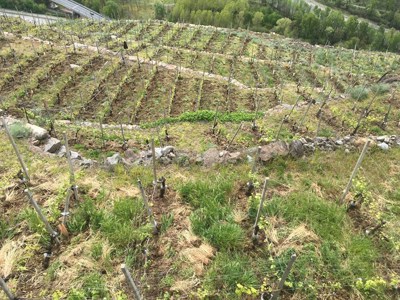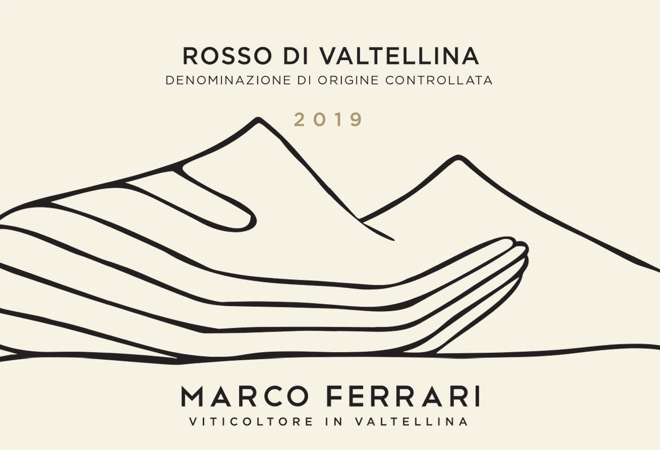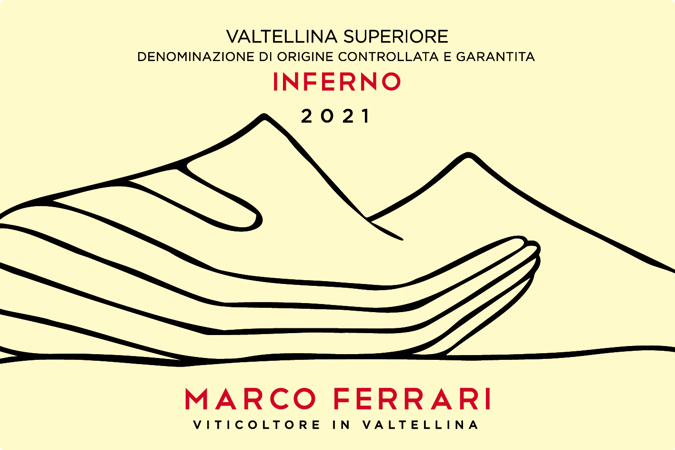Marco Ferrari
Overview
Marco Ferrari launched his eponymous Valtellina estate in 2019 after working and learning in the Northern Rhône Valley.
Valtellina's steep, terraced hillsides may be even more challenging to work than Cornas's, but the local Chiavennasca (Nebbiolo) yields wines of equal distinction.
Marco has retained the best of both Italian and French winemaking traditions, with whole-cluster fermentations, long macerations, and aging only in neutral wood.

Marco Ferrari Gallery
Nearly 200 miles to the Langhe's northeast is a little-known but great Nebbiolo region whose extreme terroir rivals even the steepest vineyards of the northern Rhone or the Mosel: Lombardia's Valtellina.
In Valtellina, intrepid viticoltori perform backbreaking work, tending Nebbiolo vines along the region's narrow terraces of weathered schist and granite.
Not only is this work done entirely by hand, but so is the maintenance of the dry stone walls that hold the terraces in place. The work here is—in fact—so demanding that only a handful of growers continue to bottle the wine commercially.
Fortunately, a gifted new viticoltore, Marco Ferrari, founded his own estate in 2019 and, with a love for traditional winemaking, is already making some of the region's most distinctive, terroir-expressive wines.
Time with the Masters
Ferrari began his winemaking career in Lombardia's Franciacorta appellation. But it was his three years in the northern Rhône, working first for Domaine Coursodon in Saint-Joseph and then with old-school Cornas star Franck Balthazar, that primed him to establish his own domaine.
During his time in the Rhone, Marco studied the practices of the norther Rhône's greatest traditional growers like, Thierry Allemand, the Clape family, and Pierre and Jean Gonon.
Through his close relationships with these illustrious vignerons, Marco gained a deep knowledge and understanding of what it takes to work steep, rocky terroirs where mechanization is impossible.
As he had in France, Marco took a position at ArPePe, arguably Valtellina's most revered domaine, learning from the masters while gradually building his own estate. He started with one hectare of vines for his first vintage of 2018, to1.6 hectares in 2020 and to 2.5 hectares by 2021, allowing him to leave ArPePE to devote himself full-time to his own wines.
A Terroir Apart
Formed by glaciers, and subsequently deepened by the westward course of the Adda River, the Valtellina is a narrow, sheltered valley, with the Rhaetian Alps on its north side and the Bergamo range to the south. The mountains shield the valley from inclement weather, making it a suntrap in the summer, with dry and sunny conditions, and by fall brings the wide daily temperature swings that great Nebbiolo needs as it finishes its ripening.
The only exposures in the valley that will consistently bring the late-ripening Nebbiolo to full maturity lie on the Rhaetian Alps' southern faces. Ranging from 750 to a dizzying 2,500 feet in elevation, they comprise one of the world's most demanding wine terroirs.
Marco's Sassella and Inferno bottlings are sourced from prime, south-facing sites with vines averaging over 80 years old. Marco's ethereal Rosso di Valtellina also comes from Sassella and Inferno but is a blend of fruit from several different parcels scattered around the steep slopes.
Sassella is named for the sassi, large stones, in its gravelly slope which bulges from the valley wall. Sassella's well-drained, very sunny aspect brings its Nebbiolo to elegant, spicy complexity, with well-integrated tannins. Inferno ("hell") is a tiny, especially steep zone of tiny terraces with multiple exposures-warmer, as its name suggests- than Sassella, producing rich, powerful Nebbiolo of striking minerality.
The Wines
In the cellar Marco works traditionally and simply, inspired by the methods of his friends in the northern Rhone and at ArPePE. Marco ferments with the native yeasts—in whole clusters a la Allemand and the Balthazar when the stems are ripe—in small stainless-steel tanks, macerating for about three weeks with twice daily punching down of the caps.
He then ages his wines on the lees in neutral demi-muids from the Rhône, with months for the Rosso di Valtellina and a year and a half for the Inferno and Sassella, before bottling without fining or filtration. All cellar operations are carefully timed to the lunar phases, sulfur usage is minimal, and the wines are further aged in bottle prior to release.
Through this painstaking, time-honored approach, Ferrari fashions strikingly pure expressions of his three Valtellina cuvées. The Rosso di Valtellina is the very definition of floral, precise, mid-weight, mountain Nebbiolo. The Sassella, while similarly supple and elegant, is much deeper and more complex, the qualities that make it the revered "Chambolle" of the region. And Marco's Inferno—which he jokingly calls his "Chaillot" in reference to Balthazar's flagship ancient-vine cuvée—is more broad-shouldered and powerful, while retaining its schist-derived detail and minerality.
Background
After working in his native Franciacorta region, Marco Ferrari spent several years working in the Northern Rhône with Frank Balthazar, and learning from other producers like Allemand and Gonon. He returned to Italy in 2018 and worked a year at ArPePe while he searched for his own vineyards. He launched his eponymous estate with the 2019 vintage; adopting whole bunch fermentations (when stems are ripe), and long macerations. No artificial fertilizers, herbicides or pesticides are employed, grapes are picked by hand, and all fermentations start spontaneously. Only minimal amounts of SO2 are added.
- Established: 2019
- Proprietor: Marco Ferrari
- Appellation: Valtellina
- Soils: A diverse mixture of sand, gravel, and rocky soils formed as the Adda river cut through the region’s hard, granite mountains. The precipitously steep, hillside plots are only held in place by stone walls and terraces that require constant maintenance. Vineyard plots range from ~300m elevation up to 700m on the precipitous slopes here.






